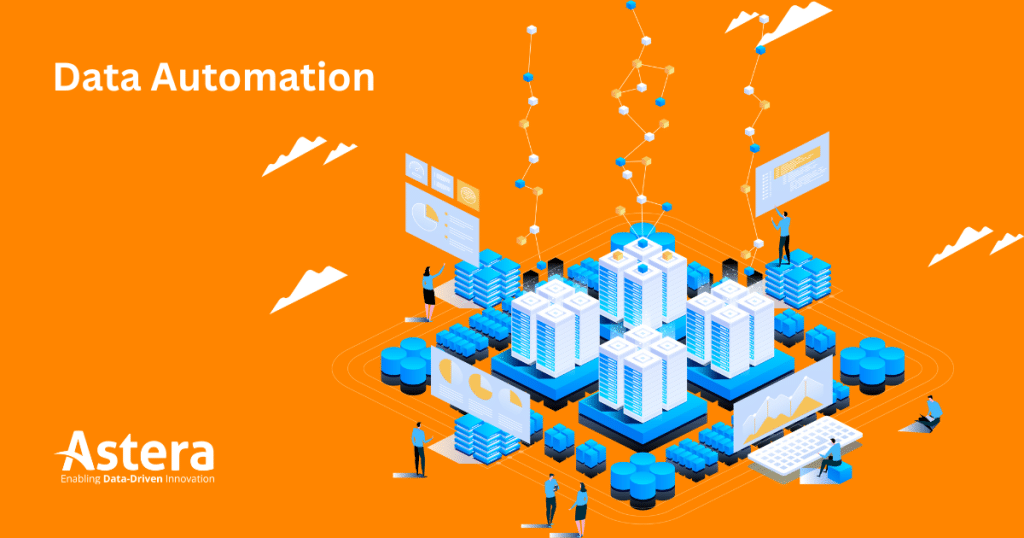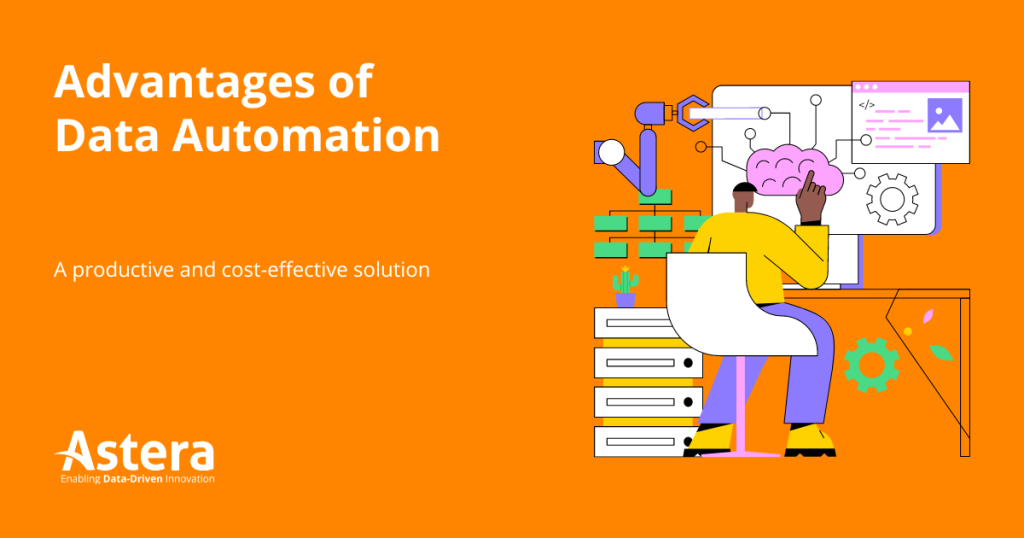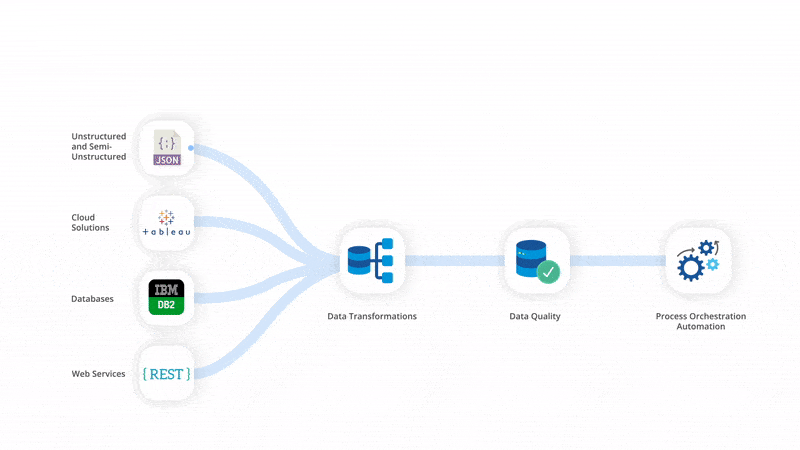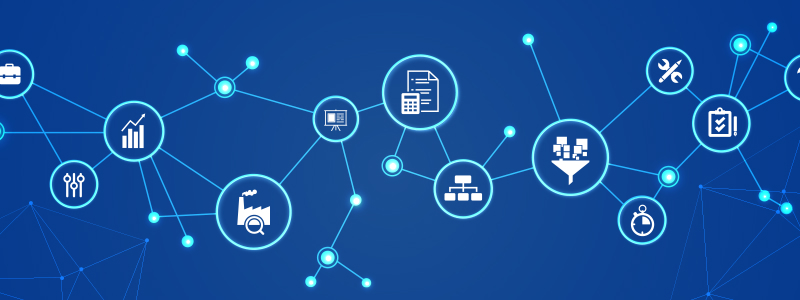
Data Automation: Everything You Need to Know

Data automation is becoming increasingly crucial for business sustainability, especially considering the exponential growth of data volume. But it’s not just the volume; data sources and data types are increasing, too.
According to the International Data Center (IDC), the global data sphere will grow to 163 zettabytes in 2025. That’s equivalent to 163 trillion gigabytes, or ten times more than the amount recorded in 2016.
For a business, big data can become a challenge or an opportunity. How would you collect, clean, and consolidate it for data management, analytics, and automation?
Yes, the whole process would be a tremendous task, but that’s where data automation comes to the rescue!
In this blog, we’ll discuss data automation, its benefits, use cases, steps of an effective automation strategy, and the future of automation tools. Let’s dive in!
What is Data Automation?
Data automation, enabled by data processing systems, is the process of uploading, handling, and processing data via automated data processing tools instead of manually performing all these tasks. The idea is to minimize human intervention when it comes to collecting, uploading, transforming, storing, processing, and analyzing data.
Data automation tools can automate repetitive and time-intensive tasks, including data ingestion, transformation, cleansing, validation, and integration.
Data automation typically involves three common elements: Extract, Transform, and Load (also called ETL). The ETL process includes three simple steps:
- Extract data from one or more sources.
- Transform into the required format of the destination system by applying transformations, such as sort, filter, etc.
- Load into the target system, such as a database or data warehouse.
Automating the process of data sourcing saves time and money while improving business efficiency. It also helps reduce errors through data validation and ensures that the loaded data is structured. Collecting essential business insights from your data is necessary for the company to progress in the right direction.
In short, having automated data processing in data analytics helps business users focus on analyzing data rather than preparing it.
Data Automation Use Cases
Data automation tools work by setting up a data pipeline that can automatically collect data from disparate sources, process and transform the data to make it suitable for the destination, and then deliver it to data warehouses or analytics and BI tools.
As the data moves through a data pipeline, different automation technologies—based on Machine Learning (ML) and Artificial Intelligence (AI)—come into play to complete the process.
Let’s look at some popular real-life data automation use cases:
1. Smart Data Capture
- Use Case: Implementing technologies like optical character recognition (OCR), barcode scanning, and object recognition to extract and process information from semi-structured and unstructured data sources.
- Example: Smart data capture automates and accelerates data extraction, applying insights in real-time and automating processes based on the extracted input. This reduces manual tasks and human error, streamlining operations in multiple sectors such as retail, logistics, and healthcare.
2. Augmented Analytics
- Use Case: Employing machine learning (ML) and natural language processing (NLP) to automate data analysis processes, enabling users to interact with data more intuitively and derive insights without extensive technical expertise.
- Example: In agriculture, augmented analytics can process data on water usage, soil conditions, and crop growth to provide actionable insights, helping farmers make informed decisions to optimize yield and resource utilization.
3. AutoAI
- Use Case: Automating the entire lifecycle of machine learning models, from data preparation and model selection to feature engineering and hyperparameter optimization.
- Example: A business aiming to predict customer responses to promotions can use AutoAI to automatically prepare data, select the appropriate model type, engineer relevant features, and optimize parameters, resulting in accurate predictions with reduced manual intervention.
4. AI-Powered Inventory Management
- Use Case: Applying AI to monitor inventory levels, predict demand, and optimize stock replenishment processes.
- Example: By implementing an AI-driven inventory management system, Amarra achieved a 40% reduction in overstocking. The system analyzed sales data and customer behavior to forecast demand accurately, allowing for more efficient inventory control.
Advantages of Data Automation: Why Is It Important For Your Business?

Data automation offers excellent incentives for businesses. It is a productive and cost-effective solution for organizations, improving work efficiency and saving costs. Furthermore, automation is also beneficial for employees, who can focus on challenging and high-stimulating activities rather than monotonous tasks.
1. Faster Time-to-Insight
Let’s face it; processing vast data volumes coming in from disparate sources is not an easy feat. Data extracted from different sources vary in format. Therefore, it has to be standardized and validated before being loaded into a unified system.
Automation saves a lot of time handling repetitive tasks that form a part of the data pipeline. Plus, it minimizes human intervention, which means less time consumed, better resource utilization, and increased data reliability.
2. Higher Profitability
The goal of any business is increased profitability, and automation has a direct impact on the bottom line as it minimizes errors and the costs associated with errors.
Do you know that rectifying past errors can cause an extra 25,000 hours yearly at a cost of $878,000? Imagine the amount of time and cost savings that can be achieved by leveraging automation.
In fact, according to a McKinsey survey, automation can enable savings of up to a whopping 30%.
3. Happier Workforce
Imagine working on a single task, such as data entry, every day for hours on end! Repetitive tasks can make teams unhappy and inefficient. This not only affects the bottom line of the company but also creates a challenge for HR teams.
Automating basic tasks allows teams to focus on more complex work and to grow in their roles. It also improves their morale and sense of belonging, allowing them to be more efficient and less likely to churn.
4. Better Performance and Scalability
Data automation ensures better performance and scalability of your data environment. For instance, by enabling change data capture (CDC), all the changes made at the source level are propagated throughout the enterprise system based on triggers. On the contrary, manually updating tasks consumes time and requires significant expertise.
With automated data integration tools, loading data and managing CDC is just a matter of dragging and dropping objects on the visual designer without writing code.
5. Improved Customer Relations
Reduced mistakes, improved efficiency, and an energized organization help improve customer service. A healthy relationship improves goodwill with customers, which can lead to smooth dealings and enhanced customer loyalty.
How to Get Started with Data Automation
Ideally, sales, customers, and inventory data should be automated. But if you consider any other type of data essential for your enterprise endeavors, it’s best to include it in the automation pipeline too. This reduces the reliance on resources and makes it easier for you to maintain data integrity and data quality in the long run.
Here is a checklist to help you decide the suitable candidates for data automation:
- Does the data require frequent updates?
- Does it require manipulation before uploading/processing?
- Is the data volume high?
- Is the data coming from heterogeneous sources?
In a nutshell, any large amounts of data that need frequent updating, transformation, or manipulation is most likely a candidate for data automation.

Adopting an Effective Data Automation Strategy: 8 Key Steps
The absence of a proper automation strategy can result in time and resource wastage for your company. It can also cost you more in terms of revenue loss. Hence, your data process automation strategy, which includes utilizing an automated data processing system, should be aligned with your company objectives.
Here’s a step-by-step guide to help you put your automation strategy to use:
1. Understand your Needs and Define Objectives
Before implementing any solution, you need to fully understand your data requirements. How much data do you need to process? What type of data is prevalent in your enterprise? Which data processes will benefit the most from automation? These are some of the questions that need to be accounted for.
You also need to define your objectives for using automation. Some simple objectives that can help are:
- X number of hours saved processing invoices per day.
- $Y amount saved per analyst per month.
- Reducing data migration by Z hours.
These objectives will guide you during the implementation process and will help you evaluate the effectiveness of your strategy.
2. Classify Data and Outline Access Roles
The second step is to categorize source data according to priority and ease of access. Refer to your source system inventory and identify the sources you can access. If you are using an automated data extraction tool, make sure it supports the integral formats of your business operations.
Also, determine who will have access to the data. Will access be given to each departmental team, or will it be centralized among the IT specialists?
3. Map the Workflow and Outline Transformations
The next step involves outlining the expected workflow on paper. This includes mapping out your data sources, required transformations, and destinations.
Identifying transformations is essential for converting the source data into the desired size. For instance, it could be as easy as converting complicated acronyms into full-text names or as complex as transforming relational DB data into a CSV file. It is crucial to identify the correct transformations to get the desired results during data automation, or else your entire set of data may be erroneous.
4. Select the Right Data Automation Tools
Your workflow will help you decide how you will perform the automation. You can decide to create a solution yourself through coding, or you can buy a data automation tool. Your choice will depend on your budget, scope, and human resources.
For example, small teams will find an in-house method cheaper than an enterprise tool.
5. Develop and Test the ETL Process
Based on the requirements outlined in the previous two steps, select an automation approach with all the essential features required for processing or updating data while retaining quality. Carefully evaluate the approach, whether it’s a tool or a custom solution, and tweak it where necessary.
6. Schedule Data for Updates
Next, schedule your data flows for timely updates. For this step, selecting an ETL tool with process automation features like job scheduling, workflow automation, etc., ensures process execution without any human intervention.
7. Track Performance
Continuously track the performance of your automation strategy. Monitor key indicators such as processing speed, hours saved, and errors. Regularly review and refine your workflows to optimize performance, identify areas for improvement, and adapt to evolving business needs.
8. Evaluate your Approach
Finally, evaluate your automation strategy against the initial objectives. If it’s not working, go back to the drawing board. On the other hand, if your strategy is successful, consider applying it to other processes and departments.
Future of Automation Tools
The increasing popularity of automation science has paved the way for exciting concepts in machine learning models called automated feature engineering. It’s the process of extracting features from raw data through data mining techniques and data collection. Although automated feature engineering is a comparatively new method, it can solve several data science project difficulties using real-world data sets.
Additionally, data automation tools are set to become more user-friendly and accessible. User interfaces will become more intuitive, allowing users with varying levels of technical expertise to easily configure and deploy automation processes. Integration with other systems and platforms will also become seamless, enabling organizations to leverage data from various sources and systems more effectively. Furthermore, cloud-based solutions will continue to gain prominence, providing scalability, flexibility, and cost-efficiency for organizations of all sizes.
Simplify Data Automation with Astera

Data Automation with Astera
Data analysis and automation are imperative for the longstanding sustainability of your data-driven business initiatives. Manually handling data can increase the chances of errors, execution time, and resource investment.
As we move forward, the need for quality data for business reporting will only increase. Businesses are relying more on data quality today. It can’t be recorded through manual processes, and automation solves this problem once and for all.
Data automation streamlines business processes by eliminating repetitive manual tasks, enabling you to focus on business growth. Automated data analysis further helps business users make critical business decisions promptly in real time.
Astera allows data automation through job scheduling. You can easily create data maps and automate them on events/triggers/actions, such as file drop, email, or value change. Learn how this automated solution can help you extract quality insights for business improvement.
Get a free demo to see how Astera can automate your data.
 Astera AI Agent Builder Coming Soon
Astera AI Agent Builder Coming Soon



